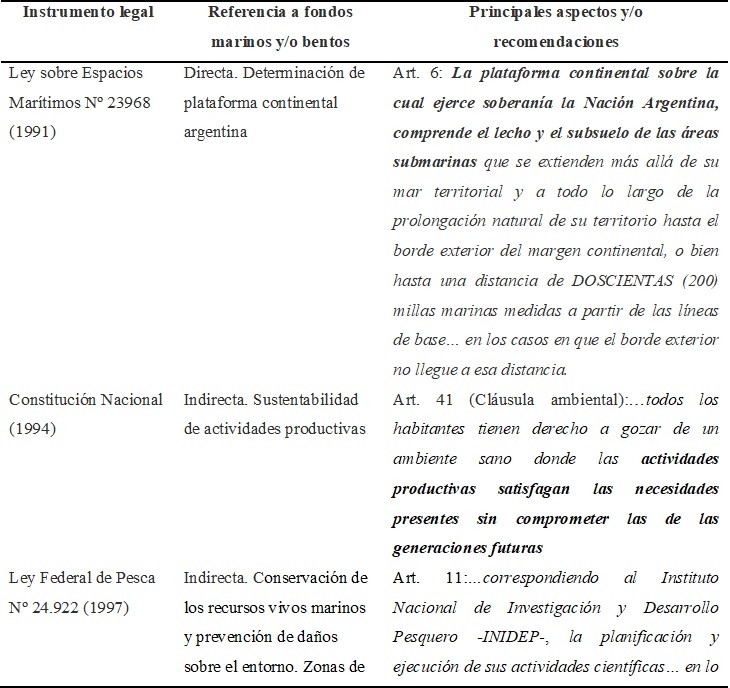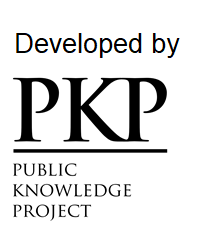Existing legislation and management instruments for the protection of seabed in the Argentine Continental Shelf
DOI:
https://doi.org/10.47193/mafis.3322020301104Keywords:
Benthic invertebrates, conservation, Marine Protected Areas, ecosystemic approachAbstract
A compendium of binding instruments and non-binding instruments referring to the management and protection of seabed and/or benthic invertebrates of the Argentine Continental Shelf (ACS) is presented. National laws and international agreements to which Argentina is a signatory were analyzed, as well as FAO declarations that established principles and norms applicable to the conservation, management and development of fisheries and associated ecosystems. Based on this selected bibliography, the evolution of measures over time was analyzed according to the international context, in order to clarify what are the shortcomings and the achievements obtained in this process. It is concluded that Argentina advanced in the generation of policies in accordance with global guidelines that imply an ecosystem management and a greater protection of biodiversity, for example implementing Marine Protected Areas, as well as the statement of research and promotion plans that involve the study of the seabed. However, effective execution of some measures is partially accomplished due to the lack of regulation and/or financing. Preparation of research plans related to the study of the seabed included in the new outer limits of the ACS is pending.
Downloads
Metrics
References
Alemany D, Iribarne OO, Acha EM. 2013. Effects of a large-scale and offshore marine protected areas on the demersal fish assemblage in the Southwest Atlantic. ICES J Mar Sci. 70: 123-134.
Allega L, Braverman M, Cabreira AG, Campodónico S, Carozza CR, Cepeda GD, Colonello JH, Derisio C, Di Mauro R, Firpo CA, et al. 2020. Estado del conocimiento biológico pesquero de los principales recursos vivos y su ambiente, con relación a la exploración hidrocarburífera en la Zona Económica Exclusiva Argentina y adyacencias. Mar del Plata: Instituto Nacional de Investigación y Desarrollo Pesquero (INIDEP). 119 p.
Auster PJ, Malatesta RJ, Langton RW, Watting L, Valentine PC, Donaldson CLS, Langton EW, Shepard AN, Babb WG. 1996. The impacts of mobile fishing gear on seafloor habitats in the gulf of Maine (Northwest Atlantic): Implications for conservation of fish populations. Rev Fish Sci. 4 (2): 185-202.
Consejo Federal Pesquero. 2017. Acta CFP N° 17/2017. Ciudad Autónoma de Buenos Aires, Argentina. 17 p.
[CCRVMA] Comisión para la Conservación de los Recursos Vivos Marinos Antárticos. 2009a. Medida de conservación 91-03. Hobart, Australia. 3 p.
[CCRVMA] Comisión para la Conservación de los Recursos Vivos Marinos Antárticos. 2009b. Medida de conservación 22-06. Hobart, Australia. 8 p.
Collie JS, Hall SJ, Kaiser MJ, Poiner IR. 2000. A quantitative analysis of fishing impacts on shelf-sea benthos. J Anim Ecol. 69: 785-798.
Cook R, Fariñas-Franco JM, Gell FR, Holt RHF, Holt T, Lindenbaum C, Porter JS, Seed R, Skates LR, Stringell TB, Sanderson WB. 2013. The substantial first impact of bottom fishing on rare biodiversity hotspots: a dilemma for evidence-based conservation. PLoS ONE 8 (8): e69904. DOI: https://doi.org/10.1371/journal.pone.0069904
[COPLA] Comisión Nacional del Límite Exterior de la Plataforma Continental. 2017. El Límite más extenso de la Argentina y nuestra frontera con la humanidad. http://www.plataformaargentina.gov.ar/es/el-l%C3%ADmite-m%C3%A1s-extenso-de-la-argentina-y-nuestra-frontera-con-la-humanidad.
Cryer M, Hartill B, O’shea S. 2002. Modification of marine benthos by trawling: toward a generalization for the deep ocean? Ecol Appl. 12: 1824-1839.
Cuminetti SI. 2020. Aspectos administrativos y legales de las áreas marinas, costeras e insulares administradas por la Estado Nacional a través de la Administración de Parques Nacionales. Rev Elect Inst Invest Ambrosio L Gioja. 24: 90-121.
[DNC/APN] Dirección Nacional de Conservación/Administración de Parques Nacionales. 2017. Sistema Nacional de Áreas Marinas Protegidas (Ley Nº 27.037): Justificación técnica para la creación de seis áreas Marinas Protegidas. Documento Técnico de la Dirección Nacional de Conservación (APN/MAyDS), Ciudad Autónoma de Buenos Aires. 52 p.
FAO. 2012. Estado de las áreas marinas y costeras protegidas en América Latina. Ed. Aylem Hernández Avila. REDPARQUES Cuba. Santiago de Chile. 620 p.
Fisher JAD, Frank KT. 2002. Changes in finfish community structure associated with an offshore fishery closed area on the Scotian Shelf. Mar Ecol Prog Ser. 240: 249-265.
Foro para la Conservación del Mar Patagónico y Áreas de Influencia. 2019. Taller Técnico sobre Implementación de Áreas Marinas Protegidas Nacionales en el Mar Argentino. Reporte final. Informe inédito. Buenos Aires. 78 p.
González A. 2012. (Re) encontrar el Mar: Argentina y el conocimiento científico de los océanos. Buenos Aires: Catálogos. 252 p.
Grizzle R, Ward L, Mayer L, Malik M, Cooper A, Abeels H, Greene J, Brodeur M, Rosenberg A. 2009. Effects of a large fishing closure on benthic communities in the western Gulf of Maine: recovery from the effects of gillnets and otter trawls. Fish Bull. 6: 308-317.
Hockings M, Stolton S, Leverington F, Dudley N, Courrau J. 2006. Evaluating effectiveness: a framework for assessing management effectiveness of protected areas. Gland and Cambridge: IUCN. 105 p.
Johnson KA. 2002. A review of national and international literature on the effects of fishing on benthic habitats. NOAA Technical memorandum NMFS-F/SPO-57.
Mauna C, Firpo C, Flores N, Mango V. 2017. Pesca experimental del cangrejo rojo (Chaceon notialis) y la langosta de profundidad (Thymops birsteini), Área I, 2017. Inf Camp INIDEP Nº 22/2017. 12 p.
Mauna C, Flores N, Mango V, Lértora P, Firpo C. 2018. Fauna acompañante de cangrejo rojo (Chaceon notialis) en el Área I, 2017. Inf Invest INIDEP Nº 45/2018. 9 p.
Muntadas A, Demestre M, De Juan S, Frid CLJ. 2014. Trawling disturbance on benthic ecosystems and consequences on commercial species: a northwestern Mediterranean case study. En: Lleonart J, Maynou F, editores. The ecosystem approach to fisheries in the Mediterranean and Black Seas. Sci Mar. 78 (1): 53-65.
Muñoz A, Cristobo J, Rios P, Druet M, Polonio V, Uchupi E, Acosta J, Atlantis Group. 2012. Sediment drifts and cold-water coral reefs in the Patagonian upper and middle continental slope. Mar Petrol Geol. 36: 70-82.
Murawski SA, Brown R, LAI HL, Rago PJ. Hendrickson L. 2000. Large-scale closed areas as a fishery-management tool in temperate marine systems: the Georges Bank experience. Bull Mar Sci. 66 (3): 775-798.
O’Boyle R. 2011. Benefits of marine protected areas and fisheries closures in the Northwest Atlantic. Can Tech Rep Fish Aquat Sci. 2948. 68 p.
Pampa Azul. 2017. Horizontes estratégicos para el Mar Argentino. Buenos Aires. 96 p.
Portela J, Acosta J, Cristobo J, Muñoz A, Parra S, Ibarrola T, Del Río JL, Vilela R, Ríos P, Blanco R. et al. 2012. Management strategies to limit the impact of bottom trawling on VMEs in the high seas of the SW Atlantic. En: Cruzado A, editor. Marine Ecosystems. In Tech. p. 199-228.
Radovich V. 2018. Innovación en las estructuras de gobernanza hacia la gestión integral del mar en la República Argentina: consideraciones sobre las áreas marinas protegidas. Rev Elect Inst Invest Ambrosio L Gioja. 20: 223-247.
Radovich V. 2019a. Indicadores de medición de eficacia de las áreas marinas protegidas (AMPs). Obs Medioambient. 22: 75-90.
Radovich V. 2019b. Gestión ambiental del Mar en la República Argentina: reflexiones sobre los parques interjurisdiccionales marino costeros y las áreas marinas protegidas. Gest Amb. 22 (1). DOI: https://doi.org/10.15446/ga.v22n1.77181
Rossi S, Bramanti L, Gori A, Orejas C. 2017. Animal forests of the world: an overview. En: Rossi S, Bramanti L, Gori A, Orejas C, editores. Marine animal forests. The ecology of benthic biodiversity hotspots. Springer. 28 p. DOI: https://doi.org/10.1007/978-3-319-21012-4_1
Sala JE. 2018. Pampa Azul: el mar como territorio. Cienc Tecnol Polít. 1: 31-38.
Schejter L, Genzano G, Gaitán E, Perez CD, Bremec CS. 2020. Benthic communities in the Southwest Atlantic Ocean: Conservation value of animal forests at the Burdwood Bank slope. Aquatic Conserv Mar Freshw Ecosyst. 30: 426-439.
Thrush SF, Dayton PK. 2002. Disturbance to marine benthic habitats by trawling and dredging: Implications for marine biodiversity. Annu Rev Ecol. 33: 449-473.
Thrush SF, Gray JS, Hewitt JE, Ugland KI. 2006. Predicting the effects of habitat homogenization on marine biodiversity. Ecol Appl. 16: 1636-1642. DOI: https://doi.org/10.1890/1051-0761(2006)016[1636:PTEOHH]2.0.CO;2
Tillin HM, Hiddink JG, Jennings S, Kaiser MJ. 2006. Chronic bottom trawling alters the functional composition of benthic invertebrate communities on a sea-basin scale. Mar Ecol Prog Ser. 318: 31-45.

Published
How to Cite
Issue
Section
License
Copyright (c) 2020 Esteban Gaitán

This work is licensed under a Creative Commons Attribution-NonCommercial-ShareAlike 4.0 International License.
Authors of articles published in Marine and Fishery Sciences retain copyright on their articles, except for any third-party images and other materials added by Marine and Fishery Sciences, which are subject to copyright of their respective owners. Authors are therefore free to disseminate and re-publish their articles, subject to any requirements of third-party copyright owners and subject to the original publication being fully cited. Visitors may also download and forward articles subject to the citation requirements. The ability to copy, download, forward or otherwise distribute any materials is always subject to any copyright notices displayed. Copyright notices must be displayed prominently and may not be obliterated, deleted or hidden, totally or partially.
This journal offers authors an Open Access policy. Users are allowed to read, download, copy, distribute, print, search, or link to the full texts of the articles, or use them for any other legal purpose within the Creative Commons 4.0 license (BY-NC-SA), without asking prior permission from the publisher or the author. This is in accordance with the BOAI definition of Open Access.




























